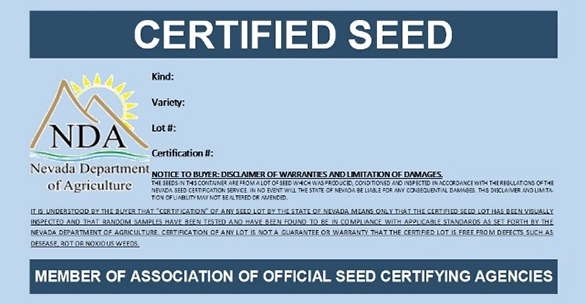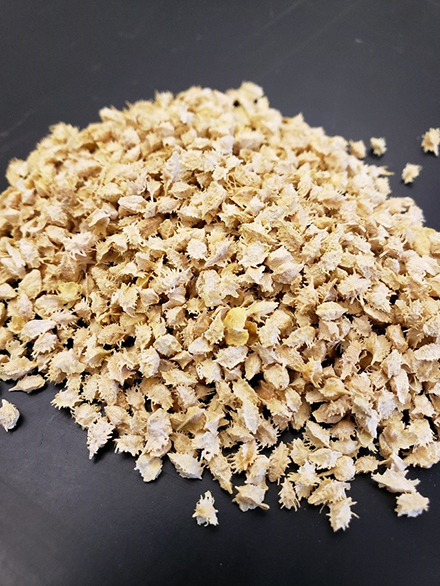Understanding the components of seed labels and certification tags is important when purchasing seed for wildland restoration projects. This fact sheet explains the common components of a seed label and the different seed certification tags issued by the Nevada Department of Agriculture and official seed-certifying agencies in other states.
Analysis Tags
All seed sold must either have an analysis tag, or a certificate of analysis associated with the lot. Some certification tags include the analysis information. Seed labels (or seed tags) provide information needed to verify the quality and amount of seed in a lot.
Typical information found on an analysis tag
| Example item |
Example value |
| Pure Seed % |
95.00 |
| Crop Seed % |
00.00 |
| Inert Matter % |
2.50 |
| Weed Seed % |
2.50 |
| Noxious Weeds |
NONE |
| Germination % |
85.00 |
| Hard/Dormant % |
0.00 |
| Total Viable % |
85.00 |
| Test Date |
03/2019 |
| Origin |
Nevada |
Federal law requires that each seed lot offered for sale – whether a single species or a mixture, certified or non-certified seed – must have a label with several specific pieces of information. Seed analysis labels are most often issued by independent laboratories. A certificate of analysis is a separate document issued by an independent seed lab that will list seed attributes and is maintained by the grower. These certificates are associated with seed lots and can be used in place of an analysis tag. Seed labels are issued by official seed-certifying agencies in some states, but currently not in Nevada.
The components of a typical seed label are:
- Variety and Species Name: All seed labels should include the species name and the variety name, if known (otherwise, variety not stated or “VNS”).
- Lot Number: All seed should include a lot number assigned by the grower for tracking purposes.
- Purity: Pure seed is the percentage of seed in a lot that is the stated species. If a lot is 90 percent pure seed then the remaining 10 percent is either other crop seed, inert matter or weed seed.
- Other crop seed must be listed by name if it is more than 5 percent of contents.
- Inert matter includes chaff, sticks, dirt and other debris.
- Weed seed includes common and restricted weed seed, but not noxious weed seed.
- Germination: The percentage of seed that germinates within a set timeline under specified lab conditions. Buyers should look for germination tests done in the previous year.
- Noxious Weeds: Each state designates which species it considers to be restricted and prohibited noxious weeds. Restricted noxious weeds must be listed by name on the tag. Seed lots that contain seed of a prohibited noxious weed cannot be sold or planted in the state where it is prohibited. See this list of noxious weeds in each state.
- Total Viability: The percentage of viable seed is the germination percentage plus the dormancy percentage.
- Dormancy: For species with seed dormancy, there is a difference between germination and viability. Dormant seeds are viable but do not germinate within the period of the germination test. A tetrazolium test, or TZ test, is used to determine if seeds are respiring and, therefore, viable.
- Pure Live Seed: Seeds for reclamation projects are typically sold on the bases of pure live seed (PLS). PLS is the amount of live, viable seed with the potential to germinate in a lot of bulk seed [%PLS = %Purity × %Total Viability].
- Origin: The location where the seed has either been grown or collected from wildlands. Knowing the origin source of seed stock can help evaluate potential for success when planting in different environments.
- Test Date: The month and year the germination test was performed.
- Net Weight: The bulk weight of the bag of seed (not PLS weight).
- Name and Address of Seller
Certification Tags
While all seed offered for sale will include a seed label, only certified seed will include a certification tag issued by the Nevada Department of Agriculture or from the official seed certifying agencies in another state. All state certification agencies comply with the requirements and standards of the Association of Official Seed Certification Agencies, so the information in this section applies to certification tags issued by any state seed certifying agency.
Certification is the process by which the Nevada Department of Agriculture, the state’s certifying agency, gives official recognition to seeds produced using a recognized seed source, grown under specified conditions, and following a limited-generation system. The certification process is designed to ensure genetic purity and identity of seed sold on the commercial market in Nevada.

Only releases are issued certification tags. A release is a plant whose seeds are made available to the public after a formal approval process has determined that the plant has stable genetics (i.e., heritability) when produced under cultivation and has desirable characteristics regarding agronomic performance and ability to establish and persist in a wildland setting. Formal approval processes are conducted by public sector entities such as the Natural Resource Conservation Service.
Official state certification programs recognize seven classes of seed for releases. The color of the seed tag corresponds to the type of release:
Cultivars
- Breeder seed is directly controlled by the plant breeding institution (either public or private) and is the source of all seed used to produce cultivars of the certified class. Breeder seed does not have an official color designation, but is typically issued a white tag.
- Foundation seed is the progeny of breeder seed that is handled to ensure genetic purity and identity. Production of foundation seed is restricted to foundation seed projects. Foundation seed has a white tag.
- Registered seed is cultivar seed that is handled under procedures acceptable to Nevada Department of Agriculture, but that is produced by a private grower. Registered seed has a purple tag.
Released Pre-Variety Germplasm (PVG)
- Tested seed are the progeny of plants whose parentage has been tested and has proven genetic superiority with stable heritability. Tested seed has a dark blue tag.
- Selected seed are the progeny of plants of untested parentage that are selected on the basis of perceived genetic superiority or distinctive traits. Selected seed has a green tag.
- Source-Identified seed are collected from uncultivated land, where no selection or testing of the parent population has been conducted. Source-ID seed has a yellow tag.
Certified
- Certified seed are the progeny of foundation or registered seed (for cultivars) or tested, selected, or source-identified seed (for released PVG) that have been grown under conditions acceptable to the Nevada Department of Agriculture. Certified seed has a light-blue tag.
 Four wing saltbush (Atriplex canescens). Photo by Russell Wilhelm.
Four wing saltbush (Atriplex canescens). Photo by Russell Wilhelm.
All tags for breeder, foundation, registered and certified seed contain the following information:
- Kind: Species’ scientific and common name.
- Variety: The official name of the release.
- Lot #: Lot number assigned by the grower for tracking purposes.
- Certification #: Assigned by the state certifying agency for tracking purposes.
All tags for released PVG contain the following information:
- Species Name: Species’ scientific name.
- Common Name: Species common name.
- Germplasm ID: The official name of the released PVG.
- Generation: Certified seed is produced under a limited generation system that ensures genetic purity. Under the limited generation system, the seed used to establish a new production field is termed G0 seed. The seed harvested in the first year after planting is termed G1 seed. Seed harvested the second year is G2 seed and so on.
- Lot #: Lot number assigned by the grower for tracking purposes.
- Certification #: Assigned by the state certifying agency for tracking purposes.
In addition, source-identified seed can contain information on:
- Seed Transfer Zone: The seed transfer zone identifies the ecological zone of adaptation for that collected material.
- Location: The county, state, and elevation from where the seed was collected.
For all other certification classes, seed transfer guidance (or “areas of adaptation”) is available in their official release documents. This information provides guidance for where the species is genetically adapted to establish and persist in a wildland setting. To find these official release documents, please refer to the Agricultural Research Service Branch of the USDA.
Treat Tags
When seeds are treated with fungicides, insecticides, or some other toxic substance, the law requires that the seed bag be labeled with a treat tag that indicates the precise treatment used.
Questions?
Contact Russell Wilhelm, Seed Program Manager, Plant Industry Division, Nevada Department of Agriculture at 775-353-3711 or rwilhelm@agri.nv.gov with any questions about seed tags in Nevada. Also visit the Nevada Department of Agriculture’s website, www.agri.nv.gov, for more information.
Taylor, M. and Wilhelm, R.
2019,
Buying Seed: Understanding Analysis, Certification and Treatment Tags,
Extension | University of Nevada, Reno


